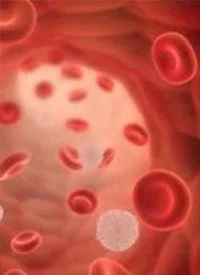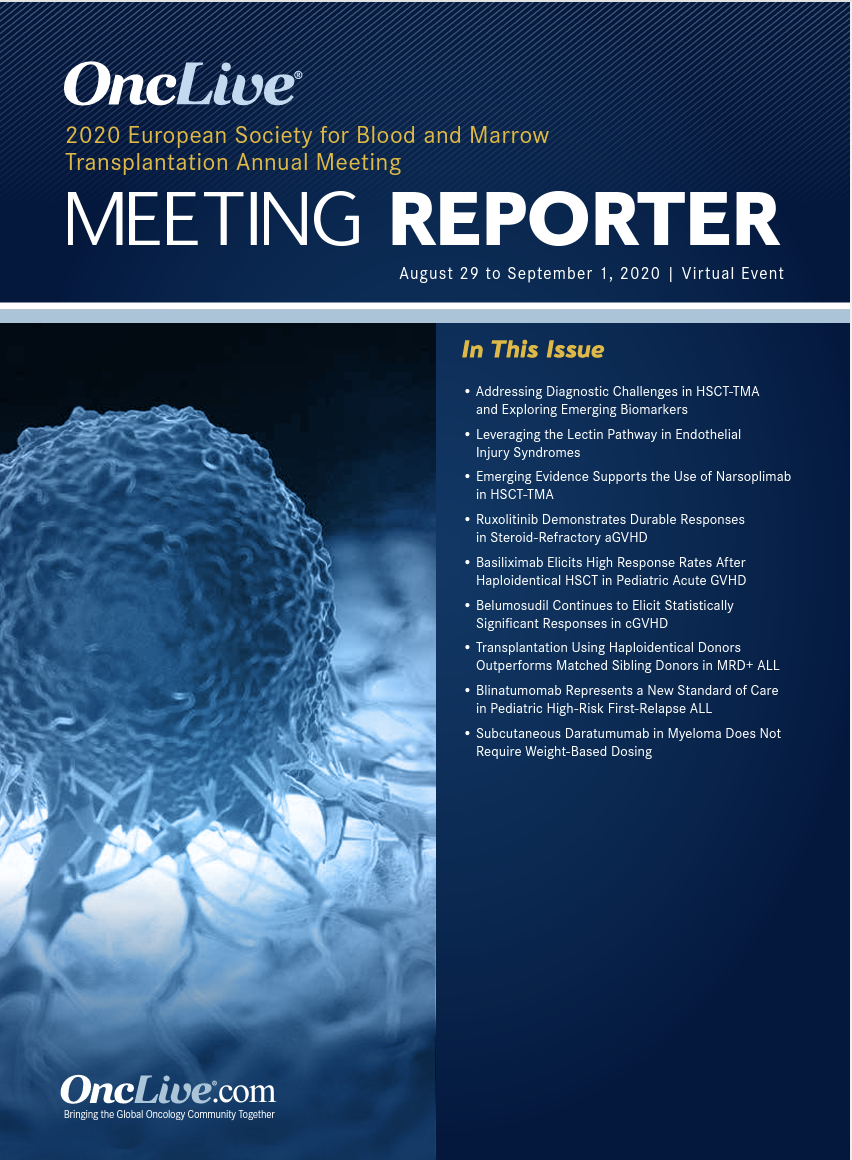Publication
Article
Supplements and Featured Publications
Blinatumomab Represents a New Standard of Care in Pediatric High-Risk First-Relapse ALL
Author(s):
Blinatumomab monotherapy as consolidation therapy prior to allogeneic hematopoietic stem cell transplant resulted a significant improvement in event-free survival and a lower risk of recurrence in children with high-risk B-cell precursor–acute lymphoblastic leukemia.

Blinatumomab (Blincyto) monotherapy as consolidation therapy prior to allogeneic hematopoietic stem cell transplant (HSCT) resulted a significant improvement in event-free survival (EFS) and a lower risk of recurrence in children with high-risk B-cell precursor (BCP)–acute lymphoblastic leukemia (ALL), according to results from a phase 3 trial (NCT02393859) presented during the 2020 European Society for Blood and Marrow Transplantation Annual Meeting.1
Results showed that patients who received blinatumomab had a much higher survival probability compared with those who were given the HC3 chemotherapy regimen comprised of dexamethasone, vincristine, daunorubicin, methotrexate, ifosfamide, and PEG-asparaginase (stratified log rank, P <.001). EFS events were reported for 32% (n = 19/54) of patients who received blinatumomab and 57% (n = 31/54) of those who received HC3 (HR, 0.33; 95% CI, 0.18-0.61). Moreover, overall survival favored blinatumomab over HC3 (HR, 0.43; 95% CI, 0.18-1.01).
Additionally, a lower cumulative incidence of relapse (CIR) following a second complete morphological remission (CR2) was observed with blinatumomab, with relapse occurring in 24% (n = 13) of those who received the monoclonal antibody versus 54% (n = 29) with HC3. At 6 months, the CIR was 10.7% (95% CI, 3.9-21.5) with blinatumomab versus 42.1% (95% CI, 27.7-55.8); at 12 months, the CIRs were 24.9% (95% CI, 13.2-38.5) versus 59.5% (95% CI, 43.0-72.6), respectively, and at 24 months, the rates were 24.9% (95% CI, 13.2-38.5) versus 70.8% (95% CI, 50.7-83.9), respectively.
Treatment with blinatumomab also resulted in superior minimal residual disease remission by PCR compared with HC3. Overall, MRD remission was achieved in 90% (n = 44/49) of those in the investigational arm versus 54% (n = 26/48) of those on the control arm. Remission of patients with MRD that was less than 10-4 at baseline was 85% (n = 17/20) versus 87% (n = 20/23) with blinatumomab and HC3, respectively. Remission in those with MRD of greater or equal to 10-4 at baseline, was 93% (n = 27/29) versus 42% (n = 6/25), respectively.
“This study clearly demonstrated the use of blinatumomab before transplantation offers an advantage in comparison with a course of chemotherapy consolidation in terms of both superior EFS, superior MRD negativity before transplant, improved OS, fewer relapses, and fewer toxicities,” said Franco Locatelli, MD, PhD, of IRCCS Ospedale Pediatrico Bambino Gesù, in a presentation during the Presidential Symposium. “The study clearly indicated that blinatumomab represents the new standard of care for this patient population.”
Relapse continues to be the main cause of treatment failure, occurring in approximately 15% of children with BCP-ALL following standard frontline treatment, according to Locatelli, and when relapse occurs, patient’s prognosis is largely dependent on the time elapsed between diagnosis and relapse as well as the site of recurrence. However, most children with the disease are eligible for allogeneic HSCT following achievement of second morphological complete remission.
Historically, the standard treatment approach for patients with high-risk, first-relapse, Philadelphia (Ph)-negative BCP-ALL is comprised of induction therapy followed by consolidation chemotherapy followed by transplant if MRD remission is achieved.
In the open-label, randomized phase 3 trial, investigators set out to evaluate the efficacy and safety of blinatumomab as consolidation treatment compared with conventional consolidation chemotherapy in pediatric patients with Ph-negative, high-risk, first-relapse BCP-ALL.
To be eligible to participate, patients had to have bone marrow blast percentage of less than 5% (M1) or bone marrow blast percentage of less than 25% and 5% or more (M2) at the time of randomization. Patients also had to be greater than 28 days old and less than 18 years of age at the time of informed consent. If they had clinically relevant central nervous system (CNS) pathology that necessitates treatment or current CNS involvement by ALL was indicated, they were not permitted for inclusion.
Participants were stratified based on their age at the time of enrollment, their bone marrow morphological status, and MRD status at the time of randomization. On the trial, participants were randomized 1:1 to receive either 1 cycle of blinatumomab at 15 μg/m2 daily as a continuous intravenous infusion for 4 weeks or 1 block of HC3 followed by 3 weeks of no treatment.2 Depending on their bone marrow status, patients who then undergo HSCT following completion of consolidation treatment.
The primary end point of the trial was EFS, while key secondary end points included OS, MRD remission at the end of treatment with blinatumomab or HC3, cumulative incidence of relapse, incidence of adverse effects (AEs), and survival of 100 days after transplantation.
The trial was terminated early based on a recommendation issued by the data safety monitoring committee that came after 50% of EFS events were reported and the first interim analysis of the trial demonstrated benefit with blinatumomab. At that time, a total of 108 patients were randomized to 1 of the 2 arms, with 54 on the blinatumomab arm and 51 on the HC3 arm. The target enrollment for the trial was approximately 202 patients. The phase 3 trial remains open for long-term follow-up of enrolled patients.
The demographic and clinical characteristics between the treatment arms were comparable, overall, especially with regard to the mean time from first diagnosis to relapse, which was 21.9 ± 8.0 with blinatumomab versus 22.8 ± 12.3 with HC3, noted Locatelli.
Additional data demonstrated that in patients with a time from diagnosis to relapse of less than 18 months, 32% (n = 6/19) of those who received blinatumomab had EFS events versus 64% (n = 14/22; HR, 0.21; 95% CI, 0.07-0.59 ). In those with a time from diagnosis to relapse between 18 months and 30 months, EFS events were reported in 31% (n = 10/32) versus 61% (n = 17/28) of those in the investigational and control arms, respectively (HR, 0.43; 95% CI, 0.20-0.95).
Moreover, in patients with a time from diagnosis to relapse of less than 18 months, OS events were reported in 11% (n = 2/19) of those who received blinatumomab versus 32% (n = 7/22) in those who were given HC3 (HR, 0.23; 95% CI, 0.05-1.13). In patients with a time from diagnosis to relapse between 18 months and 30 months, OS events were reported in 16% (n = 5/32) versus 32% (n = 9/28) of patients who received blinatumomab or HC3, respectively (HR, 0.51; 95% CI, 0.17-1.53).
With regard to safety, any-grade AEs were experienced in 100% of those who received blinatumomab versus 96% of those who were given HC3. Serious AEs were reported in 24% versus 43% of patients in the investigational and control arms, respectively; grade 3 or higher toxicities were experienced by 57% versus 82% of patients, respectively.
Compared with HC3, blinatumomab had a lower incidence of neutropenia/neutrophil count decrease (17% vs 31%), anemia (15% vs 41%), leukopenia/white blood cell count decrease (7% vs 8%), cytopenia (0% vs 4%), asplasia (4% vs 8%), and febrile neutropenia (4% vs 26%), according to Locatelli. The incidence of neurologic toxicities and cytokine release syndrome proved to be comparable between the arms, he added. No fatal toxicities were reported.
References
- Locatelli F, Zugmaier G, Rizzari C, et al. Superior event-free survival with blinatumomab versus chemotherapy in children with high-risk first relapse of B-cell precursor acute lymphoblastic leukemia: a randomized, controlled phase 3 trial. Presented at: 2020 European Society for Blood and Marrow Transplantation Annual Meeting; August 20-September 2, 2020; Virtual.
- Phase 3 trial of blinatumomab vs standard chemotherapy in pediatric subjects with high-risk (HR) first relapse B-precursor acute lymphoblastic leukemia (ALL). ClinicalTrials.gov. Updated August 5, 2020. Accessed September 2, 2020. https://clinicaltrials.gov/ct2/show/NCT02393859.










